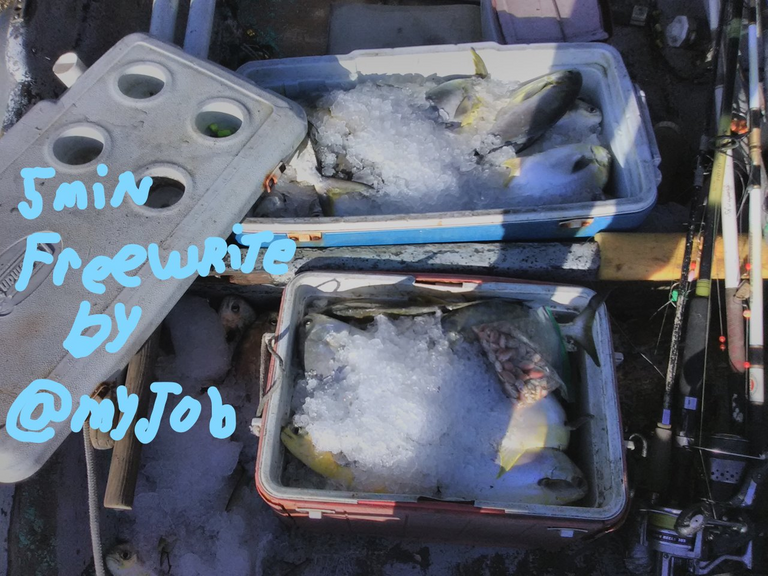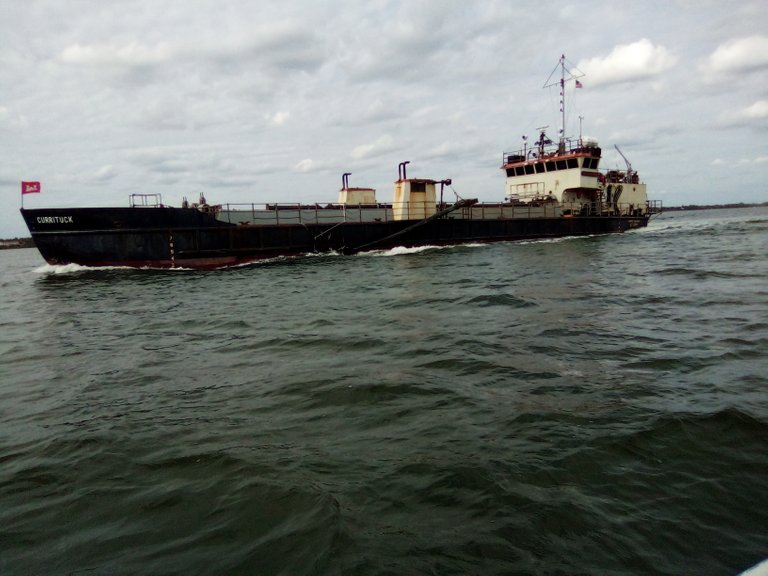No fish just shrimp

This is my post for #freewriters Thursday prompt fragile things hosted by @mariannewest
Today I ran to the big flat, the water was clear and as I rode over the shallow water, all I could see were big stingrays. I never saw any other type of fish. From there I went across black point and down to the sleuth, There was not a fish of any kind in these places either.
I was thinking about all the shrimp being caught in the channel and figured there has to be fish of some kind with all the shrimp. I stopped where all of the boats were and threw the jig several times I even put a shrimp head on the jig and dropped it to the bottom, nothing bit.
I put a four hook rig on a planer and trolled all the way to cat island and back for nothing. I did see something that I have never seen in the river, this freighter came by me.

Since I could not catch anything I decided to go back to where the other boats were catching shrimp and see if I could catch any in my little 6-foot net. I never had more than 5 on a throw but after 2 hours of throwing, I figured I had 45 or 50 of the fragile things.

A friend of mine was at the boat ramp and I gave them to her which got me in trouble with my husband. He says I should have sold them to her and that would have paid for my gas. Then went on to say he is tired of having my fuel come out of his fish. He is just going to have to get over it, I am in no mood to listen to him.
Hi myjob,
Visit curiehive.com or join the Curie Discord community to learn more.
@curie thank you and I hope you have a great weekend
That’s tough, going home empty handed. Sorry it wasn’t a good day for you! It’s hard sometimes, balancing things like selling fish versus giving someone you know who probably needs them the fish. I get both sides of the argument there! Can’t say I would have done it different but knowing money is needed is also tough.
@cmpixty this morning he apologized which makes it easier but my feelings are still hurt.
I am sorry that you didn't catch any.
What do you think that ship was doing there? (marianne)
@mariannewest I found out it is a dredge a friend looked up the name and posted it for me. What it does is interesting but I disagree with the pumping of sand to restore the beaches because to save the beach they are killing the reef, with every storm the beach erodes and all the sand is covering the reef. But tourists can not see what is happening and the state has beautiful beaches for them to enjoy.......
– From Florida to Maine, one unique vessel in the U.S. Army Corps of Engineers’ maritime fleet earns its “indispensable” reputation 363 days a year by dredging dangerous shoaling in shallow-draft federal channel inlets: hopper dredge Currituck.
The Currituck recently spent three days dredging the federal channel at Rudee Inlet in Virginia Beach, Va. and removed more than 7,700 cubic yards of shoaling sand. The Currituck hopper dredge then transported the fine sand, offloading it along the Virginia Beach coastline to replenish the city’s beachfront erosion.
Norfolk District, U.S. Army Corps of Engineers managed the maintenance project as part of their overall operations mission to ensure safe transiting of maritime traffic. Two Corps interns, Michael Weber and Bryan Hakey spent a day on the Currituck.
“As a mechanical engineer, it was very cool to see up close how this tremendous crew and piece of machinery works and benefits the communities it serves,” Weber said. “The highlight of the day was getting to operate the Currituck.”
The Currituck is assigned to the Corps’ Wilmington District in North Carolina. It’s the only special-purpose type of hopper dredge in the United States that works the same projects as larger sidecasting dredges, only on a smaller scale. It features a self-propelled split hull and is equipped with a self-leveling deck-house located at the stern, where all controls and machinery are housed. The Currituck is hinged above the main deck so that the hull can open from bow to stern by means of hydraulic cylinders located in compartments forward and aft of the hopper section.
The Currituck operator steers the vessel through the shoal areas of the channel. The dredge pumps, located in the compartments on each side of the hull, then pumps material through trailing diagrams into the hopper section.
The Currituck’s lone hopper section has a maximum capacity of 315 cubic yards and during operation the hopper section is clearly visible to the operators in the pilothouse, making production monitoring an easy task, said John Petersen, Currituck first mate.
“During our dredging operation here, we limited our capacity to between 200-225 cubic yards. With the fine material in Rudee Inlet and the disposal site so close, it was more efficient and productive to take smaller loads,” Petersen added.
The Currituck crew is comprised of highly trained professionals whose backgrounds and experience range from prior service with the U.S. Army, Coast Guard, and Navy, to a graduate of the Maine Maritime Academy, who is now serving on another Wilmington District vessel.
Petersen, a retired U.S. Army chief warrant officer, has been with the Currituck crew for nearly three years. He said unusual items are recovered by Currituck dredging operations: “Tires, spear guns, swimsuits, towels, more than 100 Frisbees on one project, 500 golf balls on another.”
The Currituck and its two crews work 12-hour daily shifts, year-around: eight days on, six days off, except for Thanksgiving and Christmas. ”I believe the Currituck dredges more days each year than any other dredging vessel in the Corps fleet,” Petersen said.
Although the Currituck crew is called upon to work long hours, the great support they receive from the Corps districts they serve is indispensable, said Capt. Donnie Potter, Currituck skipper.
“Norfolk District has always gone the extra mile to ensure our dredging mission here is a success,” Potter said. “Their great logistical, survey, and operational support provide the Currituck crew more time to concentrate on removing dangerous shoal areas that limit safe maritime navigation for local users.”
The Currituck’s next federal channel dredging project is the Oregon Inlet on the Outer Banks of North Carolina, followed by a real hardship mission -- Daytona Beach, Fla.
Thank you! They are doing it here as well.
It is so true - one problem solved, another created...
Wow! That was so selfless of you. Sorry you didn't get any fishes. Are they sometimes scarce like this?
@wems yes we do not have many fish that live in our area year-round, most are migratory we catch them as they are going by. When they all go south for the winter, it leaves us with nothing to catch, that is why we trailer our boats south but in very cold winters they go too far south and with the price of fuel, it is not profitable for us.
Ooh. Thanks for explanation. That was insightful.